DAVID HENNING LARSON
September 27, 1931 - August 5, 2007
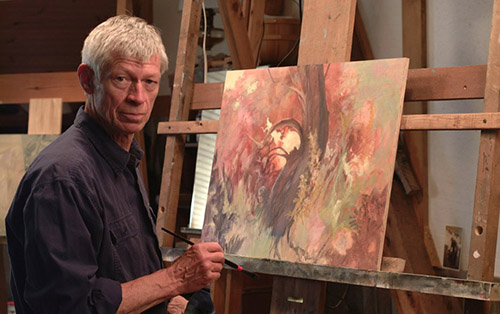 David circa 2001
"I want all my work to reflect the density of our experience, so every character is part of us at one time
or another.
The asylum is where we drop our guard - where we are placed sometimes reluctantly, sometimes with relief,
where normality is a mask and we can accept a form that belies 'normal'
proportions and relations.
However, embracing normality is
as absurd as embracing absurdity - and what seems to be teeming with
life can be allusive and point to our ultimate dilemma - our aloneness.
My reality is an infinitely meaningful
absence of meaning. I retreat from all points of view except this.
Hence I can only paint what I mean
by refusing to mean what I paint."
- From 2001 Artist Statement.
David circa 2001
"I want all my work to reflect the density of our experience, so every character is part of us at one time
or another.
The asylum is where we drop our guard - where we are placed sometimes reluctantly, sometimes with relief,
where normality is a mask and we can accept a form that belies 'normal'
proportions and relations.
However, embracing normality is
as absurd as embracing absurdity - and what seems to be teeming with
life can be allusive and point to our ultimate dilemma - our aloneness.
My reality is an infinitely meaningful
absence of meaning. I retreat from all points of view except this.
Hence I can only paint what I mean
by refusing to mean what I paint."
- From 2001 Artist Statement.
"I think all the great works
do not deal with morality, they simply are. And they don't take stands,
they don't make moral issues out of things. They basically articulate
a mystery, which is a contradiction in terms I realize, but that's what
art I think does, articulates the mystery.""
- From 1994 interview.
Resume
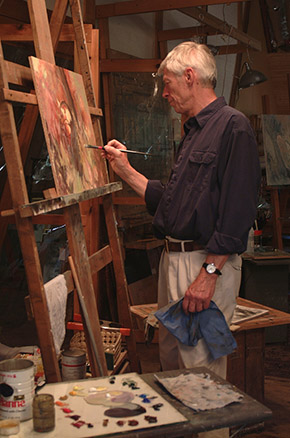 Pratt Institute 1949 - 1958, graduated
with a B.F.A.
Pratt Institute 1949 - 1958, graduated
with a B.F.A.
U.S. Air Force 1951 - 1955.
Art Director, Doyle Dane Bernbach,
N.Y. 1958-1971.
Creative Director, Doyle Dane Bernbach,
London. 1964-1966.
Studied with James Brooks and Jack
Tworkov at Pratt Institute in the 1950's, and worked with the sculptor
Reuben Nakian in the 1960's.
Moved to Penobscot, Maine in 1971.
Works shown in the Farnsworth Museum, the Portland Museum of Art and numerous other galleries.
Opened Larson Fine Art in 1984, showing
Larson work exclusively. Renamed gallery 'Larson Studio and Gallery' in
2002.
Posthumously appointed a 'Maine Master' by the Union of Maine Visual Artists in 2011.
Bio
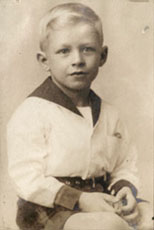 David Henning Larson was born in Flushing, New York on September 29, 1931, the second child of Frank and Eleanora Larson. David was raised in a modest home on Oak Avenue and lived there through his school years. Both Frank and Eleonora were children of Swedish immigrants who came to America in the 1890's. Frank's father Johan Oscar Larson worked as a foreman at Hecla Ironworks in Williamsburg, Brooklyn. Eleonora's father Johan Frieberg also worked at the same company as a patter maker. Hecla Ironworks was well known at the turn of the last century for producing decorative ironwork. They produced eleborate iron facades and railings for city homes and turn-of-the century landmark city buildings like the New York Life Building, Grand Central Terminal and the original IRT subway entrances.
David Henning Larson was born in Flushing, New York on September 29, 1931, the second child of Frank and Eleanora Larson. David was raised in a modest home on Oak Avenue and lived there through his school years. Both Frank and Eleonora were children of Swedish immigrants who came to America in the 1890's. Frank's father Johan Oscar Larson worked as a foreman at Hecla Ironworks in Williamsburg, Brooklyn. Eleonora's father Johan Frieberg also worked at the same company as a patter maker. Hecla Ironworks was well known at the turn of the last century for producing decorative ironwork. They produced eleborate iron facades and railings for city homes and turn-of-the century landmark city buildings like the New York Life Building, Grand Central Terminal and the original IRT subway entrances.
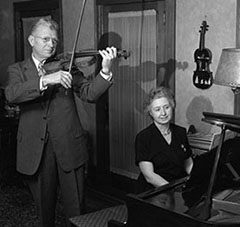 David's father Frank, born in 1896, served in the U.S. army during WW1. He was assigned to an artillery unit in France where he sustained a mustard gas attack in 1918 that damaged his lungs. Discharged when the war ended, he was officially listed as a disabled veteran.
After the war Frank got a job working with the Empire Trust Company, a bank in midtown Manhattan. He worked at the same firm until his early retirment in 1960 due to his lung injuries.
To relieve the boredom of his 9 to 5 job, Frank took up various artistic pursuits, including wood carving, playing the violin and amateur photography.
Eleanora was a homemaker and an accomplished pianist in the popular music tradition. Together with Frank, the two often played music together, including forming a group that for many years performed square dance music for troops stationed at Fort Totten in Whitestone, Queens.
David's father Frank, born in 1896, served in the U.S. army during WW1. He was assigned to an artillery unit in France where he sustained a mustard gas attack in 1918 that damaged his lungs. Discharged when the war ended, he was officially listed as a disabled veteran.
After the war Frank got a job working with the Empire Trust Company, a bank in midtown Manhattan. He worked at the same firm until his early retirment in 1960 due to his lung injuries.
To relieve the boredom of his 9 to 5 job, Frank took up various artistic pursuits, including wood carving, playing the violin and amateur photography.
Eleanora was a homemaker and an accomplished pianist in the popular music tradition. Together with Frank, the two often played music together, including forming a group that for many years performed square dance music for troops stationed at Fort Totten in Whitestone, Queens.
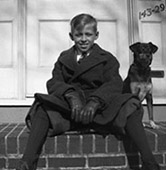 Growing up in Flushing, David lived a fairly normal life and enjoyed the kinds of things most boys his age did; playing baseball in nearby Kissena Park with his neighborhood friends, riding his bicycle and playing with his dog. David's early life was without any dramatic or traumatic events. His father kept his job through the depression so his family never went wanting for food or shelter.
Growing up in Flushing, David lived a fairly normal life and enjoyed the kinds of things most boys his age did; playing baseball in nearby Kissena Park with his neighborhood friends, riding his bicycle and playing with his dog. David's early life was without any dramatic or traumatic events. His father kept his job through the depression so his family never went wanting for food or shelter.
David and his brother Franklin, six years older, both started piano lessons at an early age. For David, music was his first artistic love. His music teacher, Mr. Jehu Hanson, a Juilliard trained pianist and organist, saw considerable promise in David, and nurtured his love of classical music.
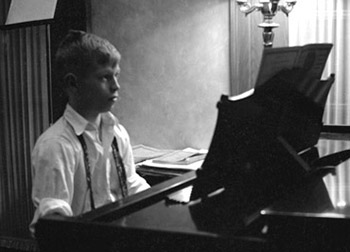
For David, the discipline required to play the piano and the experience of performing the great works of classical music were instrumental in his development as an artist. Music, David would say, taught him early on that, "Do something fine, and it's its own reward." David said it was Mr. Hanson who, perhaps unknowingly at the time, triggered his interest in the visual arts.
Sometime when David was still very young, Mr. Hanson bought him a big, encyclopedic book of art history. David described how his teacher would open it to a painting and ask David to study the work and they would talk about how the artist used technique and composition to help tell a story and achieve a goal. Mr. Hanson would tell David to apply this same process to analyze a piece of music. David would say that his study of music exposed him not only to the "magic" that great art provided, but also laid the foundation of his awareness of the importance of form and composition in art.
 After 12 Years of classical piano training, David became quite accomplished. He was considered the official pianist at Flushing High School.
After 12 Years of classical piano training, David became quite accomplished. He was considered the official pianist at Flushing High School.
But despite the rewards playing the piano offered, David's attention was increasingly being pulled towards the visual arts. Upon graduation from high school, David enrolled in Pratt Institute in Brooklyn to study commercial art. He spent a little over a year there before enlisting in the Air Force in 1951. The Korean War was going on and he enlisted so he would have some control over his military service.
David spent his four years of service based mostly in England. It was the time of the Berlin Air Lift and his base was involved in this operation. Most significant during this time for David was meeting a young British woman named Carole Ann Hill, who he would go on to marry and live together for over 50 years.
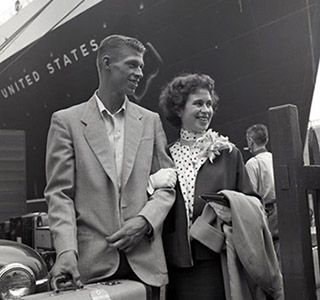 David and Carole on her arrival to New York in 1955
David and Carole on her arrival to New York in 1955
After completing his service duty in 1955, David returned to New York and Pratt Institute. Carole also came over in 1955 and the two got married in 1956. They settled in Brooklyn near Pratt, where David graduated in 1958 with a BFA.
While at Pratt, David had the chance to study with some of the prominent artists of the day, including James Brooks and Jack Tworkov. Abstract Expressionism was the prevailing style at that time, and although David was never enamored with it, he did produce a few works in that style. He also began to devote a lot of time to sculpture. Later David would speak highly of his time at college, saying "Pratt was very good for me, good discipline." Aside from design and life drawing lessons, David also learned a lot about lettering and advertising design, skills that would prove important in the next phase of his life.
Early Career in Advertising
After graduating, David landed a job with the advertising firm Doyle Dane Bernbach. At that time Doyle Dane Bernbach (DDB) was one of the most respected and innovative advertising companies in the world, and often cited as the firm that inspired the 'Mad Men' TV series. David began working as an assistant to art director Helmet Krone.
Krone was the creator of the legendary Volkswagen ads of the late 50's and early 60's, as well as many other well known campaigns. After working as Krone's assistant, David went on to art direct his own ads for Volkswagen, Polaroid and others.
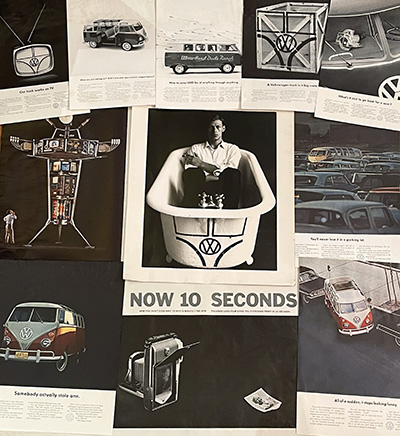 David surrounded by montage of some of his DDB ads ( click here ) to enlarge
David surrounded by montage of some of his DDB ads ( click here ) to enlarge
David's career in advertising was short but successful. In 1964 he was sent by DDB to England to open the London office with his friend and writer John Withers. Two years later he returned to the states and settled in the town of Ossining, New York. In 1969 he won a Cannes Lion for a public service ad for United Cerebral Palsy called 'Have a Cigar.'
In 1959, David and Carole had their first child, Adam, and had two more - Soren in 1961 and Anders in 1964.
 During his years on Madison Avenue and even earlier during Pratt, David's passion was art and specifically sculpture. He would often come home at night and mix up a batch of plaster to create large female torso's and other works. His influnces ranged from works of antiquity to Maillol, Picasso and many others. In sculpture he also worked in wax, marble and wood.
During his years on Madison Avenue and even earlier during Pratt, David's passion was art and specifically sculpture. He would often come home at night and mix up a batch of plaster to create large female torso's and other works. His influnces ranged from works of antiquity to Maillol, Picasso and many others. In sculpture he also worked in wax, marble and wood.
Throughout his life David was a prolific draftsman, always with a sketch pad handy. He would say that drawing was the foundation of everything he did artistically.
As he approached his 40's David was becoming increasingly disenfranchised with the advertising business. In the early 1970's the industry was increasing being driven by marketing and focus groups - the creative people no longer called the shots. But more importantly, David knew it wasn't his life's work. He was "never all-in," as he would frquently say. So in 1971 David quit his job at DDB and moved to the small coastal town of South Penobscot, Maine to fulfill his life's dream of being an artist.
In Penobscot He and Carole found a recently closed down canning factory that until 1969 had been used to can local produce - including everything pumpkins, squash, corn and blueberries. A collection of connected wood buildings, David knew it would provide the open space to work, create, and build a home.
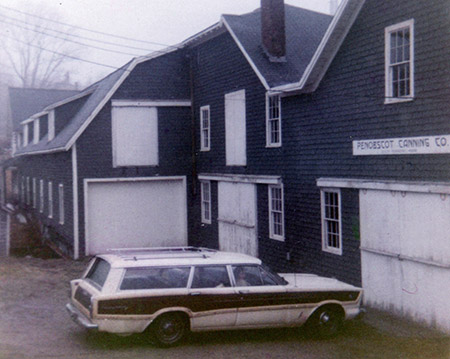 The canning factory when first discovered by the Larson's in 1970
The canning factory when first discovered by the Larson's in 1970
Life in Maine
 In order to support the family David became a carpenter and Carole a weaver. Carole had started weaving in Ossining a few years earlier as a hobby and David had inherited his carpentry skill from his father.
In order to support the family David became a carpenter and Carole a weaver. Carole had started weaving in Ossining a few years earlier as a hobby and David had inherited his carpentry skill from his father.
After a few years of doing odd jobs around the area, David teamed up with Peter Yoder, who also moved to Penobscot but from upstate New York, and together they started South Penobscot Wood Works. The factory provided all the space they needed and they used it to make furniture, kitchen cabinets and other works. David brought his artistic touch to much of the furniture they made. They also did construction projects on many homes in the area, including building some from the ground up for clients.
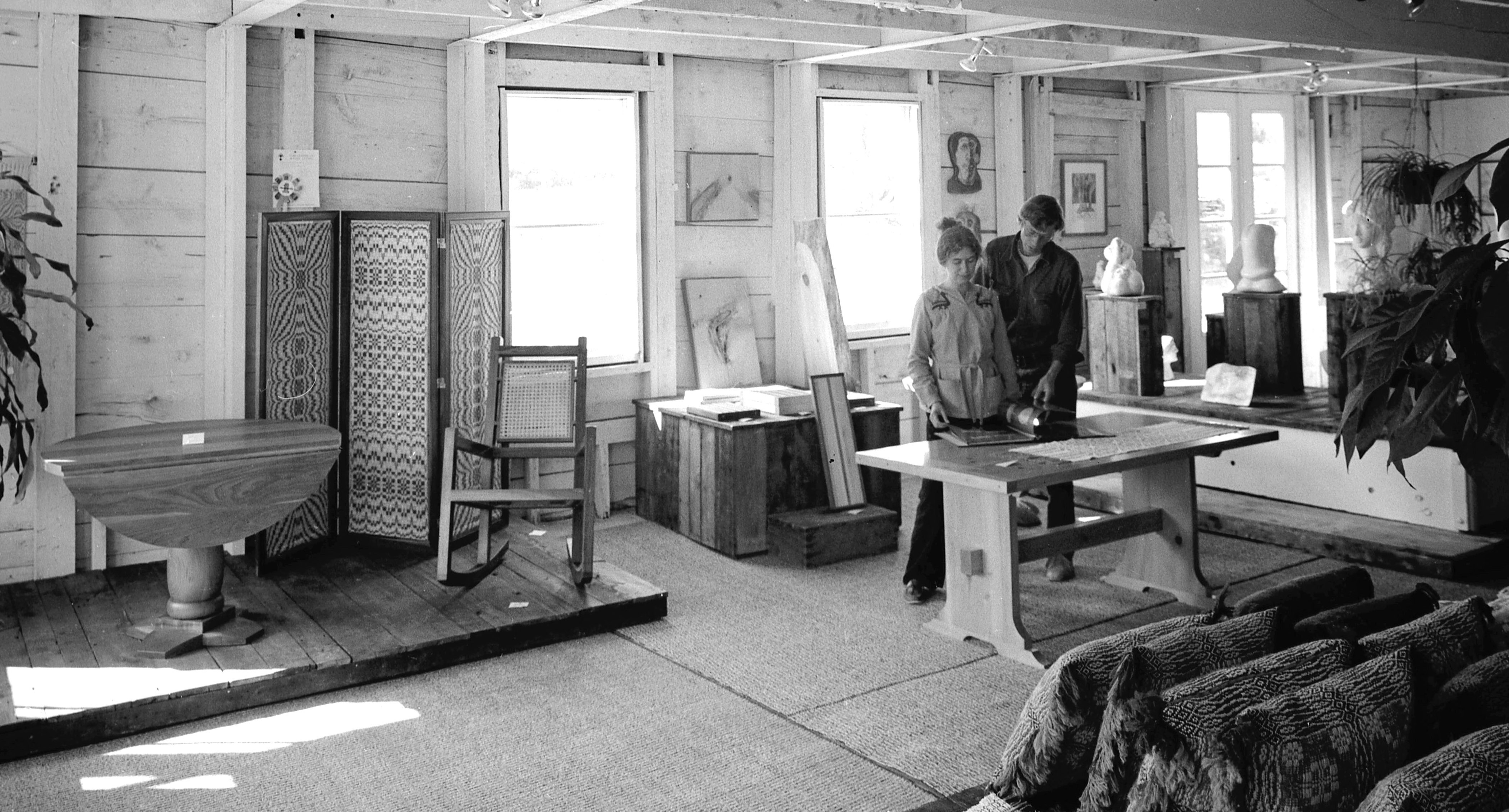 David and Carole in the Gallery circa 1976
David and Carole in the Gallery circa 1976
Carole joined together with three other local weavers and started North Country Textiles in 1976, making handwoven clothes, wall hangings and home items like pillows and table runners. The partnership used the space that would later be known as the Gallery. They began selling their weaving both via wholesale to catalogs and in the summer to tourists from the gallery storefront. The store also served as a venue for David to display his art and some of the woodwork's furniture.
In 1984 David converted the floor over the store into gallery space and opened Larson Fine Art. In 2002 he renamed it Larson Studio and Gallery and it remains open on a seasonal basis until 2012.
Throughout the 1970's and 80's, although carpentry was a full time job for David, being his own boss and having the space to create allowed him to focus much more intently on his art than was possible during his years in advertising. Beginning in the early 1990's, David would slowly taper off the time spent making furniture and spend more time on art. The last 10 years of his life would be spent doing art full time and tending the gallery.
In the 1970's David focused on sculpture, working in plaster, wax and marble. During the 1980's his attention gradually shifted towards large drawings and painting. In the last two decades of his David stopped working on sculpture and focused entirely on painting, drawing and other works on paper.
David often worked in 'series', taking a theme that intrugued him and exploring it through many works, sometimes spread out over many years. In the mid 1970's to early 1980's he did a series of drawings and works on paper called 'Mutations'
In the early 80's, partly inspired by the artist Francisco Goya, David did a series of large drawings, many of them starting with a composition by Spanish Master and then transforming it, altering the subject matter and making something new and uniquely his own out of it.
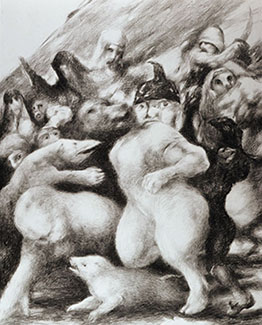 Big Pig - 1981
Big Pig - 1981
A few years later David wrote, "Consider the Goya - any series of his etchings, and the rush of technical certainty that accompanies them. I have always respected that approach to be legitimate in the pursuit of a thought, a philosophy of form and subject that is impossible to contain in a single work."
The last 15 years would be the most productive of his artistic career. In the early to mid 90's he would produce his monumental 'Last Supper' and 'Moby Dick' series of paintings and drawings. These series didn't illustrate the literary stories, but were inspired by them - they were the launching point for artistic exploration.
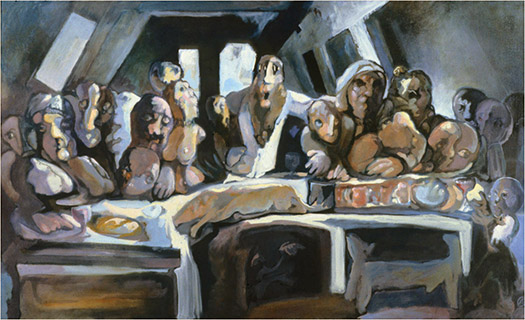 The Last Supper - Long Table
The Last Supper - Long Table
David would later say that he chose those two subjects intuitively because "They've got that stuff I love to have in a painting. It's a sense of time, it's a sense of tension, it is contradictory, it is upsetting, it is multi-faceted, it is complex, dense, and the denser the richer the thing is better I like it."
The next great series was the 'Asylum' series which he began in the late 1990's. Again, it has it's orgin in words, specifically the dual nature of the idea of Asylum, which can mean a safe place, a haven, but also something threatening, a place we put people we don't know what else to do with.
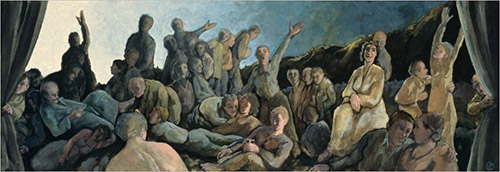 Asylum with Matron
Asylum with Matron
"The idea of Asylum has always occured to me as the kind of contradiciton that we live, that we can find something so simple as asylum and it means two totally different things," wrote David in 1999. "So perhaps the tragic/comic world which has led me to the Asylum series is the one motive that I and my art can live with. Haven or prison? Who is in? Who is out?"
In the early 2000's David produced his 'Alone Together' series, which he onced described to me as "a fucked up happy snap," which formally depicts family posing together as if for the camera. In 2002 David would say, "The feeling of "aloneness - together", is one of the most fundamental issues of my life, art, and philosophy.” "What seems to be teeming with life can be allusive and point to our ultimate dilemma - our aloneness."
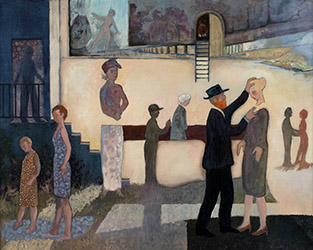 In 2003 David did a series of paintings he called the 'Dumb Show,' named after the short theatrical performances put on in the intermission of plays, especially during the Elizabethan era. Traditonall used to convey a meaning through pantomime, David was after the opposite, saying his Dumb Shows "disavow a hierarchy," and by using illogical perspective and the absurd juxtaposition of images, serves up the viewer with an image that bewilders them and leaves them with concern and disconnect.
In 2003 David did a series of paintings he called the 'Dumb Show,' named after the short theatrical performances put on in the intermission of plays, especially during the Elizabethan era. Traditonall used to convey a meaning through pantomime, David was after the opposite, saying his Dumb Shows "disavow a hierarchy," and by using illogical perspective and the absurd juxtaposition of images, serves up the viewer with an image that bewilders them and leaves them with concern and disconnect.
"In the process of pantomime are we forced into more basic, clean gestures? No illustrations, no complex descriptions, no music, no thunder, no psycho-babel, no smoke, no mirrors. Redon would say everything is smoke and mirrors," wrote David in 2003. "Or maybe the only way to understand myself is to end this verbal bull shit and paint my way into understanding that there is no understanding. There is only the desire."
'The Neighborhood'and 'Occupied Structures' series followed in 2005 and 2006. But throughout all of these series and before, David produced many individual works that were not part of a series, and highlights of his output from the 1980's, the 1990's and the 2000's illustrate his creativity and range. Although the majority of David's work were the product of his imagination, he also did drawings from life including portraits and figure drawings, landscapes, still lifes and other works.
His last series, 'Falling Man,' wss painted during the final 12 months of his life. David used the phrase "of plainess and of madness" to describe the series, adding, "The idea of urban and corporate capitalism and the dehumanization that is involved began to assume proportions that I thought important to delve into, with wit and wisdom to be sure, but mostly paradoxically, blatantly, absurdly."
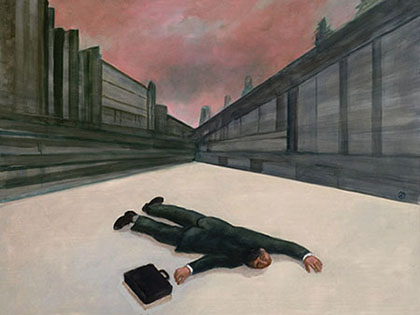 A Deficient
A Deficient
"So, possible a man or woman, possibly dead, certainly incapacitated, definitely a bother that is unexplained, should be explored. I have done about a dozen with supine people – all enigmatic, all absurd."
Aside from showing his work at his own gallery, David had a number of one person shows in the area as well as participating in a many group exhibitions. His work has been shown in the Portland Museum of Art and the Farnsworth Museum in Rockland, Maine.
Despite this modest success locally, David did very little to promote his art to a larger audience, preferring to rely on his own gallery for exposure. 13 years in the advertising business had turned David against salesmanship and marketing and he would often say his attention was better spent making art, not promoting himself. Each year he would make enough on art sales, along with the income from Carole's weaving business, to maintain a modest lifestyle.
On August 25, 2007 David passed away quite suddently from a fast spreading form of lung cancer.
It is my hope that this web site will lead to a greater appreciation of David's work and expose his art to a wider audience. - Soren Larson
 David, Carole, Adam, Soren and Anders Larson in New York in 1999
David, Carole, Adam, Soren and Anders Larson in New York in 1999
 Pratt Institute 1949 - 1958, graduated
with a B.F.A.
Pratt Institute 1949 - 1958, graduated
with a B.F.A.
 David Henning Larson was born in Flushing, New York on September 29, 1931, the second child of Frank and Eleanora Larson. David was raised in a modest home on Oak Avenue and lived there through his school years. Both Frank and Eleonora were children of Swedish immigrants who came to America in the 1890's. Frank's father Johan Oscar Larson worked as a foreman at Hecla Ironworks in Williamsburg, Brooklyn. Eleonora's father Johan Frieberg also worked at the same company as a patter maker. Hecla Ironworks was well known at the turn of the last century for producing decorative ironwork. They produced eleborate iron facades and railings for city homes and turn-of-the century landmark city buildings like the New York Life Building, Grand Central Terminal and the original IRT subway entrances.
David Henning Larson was born in Flushing, New York on September 29, 1931, the second child of Frank and Eleanora Larson. David was raised in a modest home on Oak Avenue and lived there through his school years. Both Frank and Eleonora were children of Swedish immigrants who came to America in the 1890's. Frank's father Johan Oscar Larson worked as a foreman at Hecla Ironworks in Williamsburg, Brooklyn. Eleonora's father Johan Frieberg also worked at the same company as a patter maker. Hecla Ironworks was well known at the turn of the last century for producing decorative ironwork. They produced eleborate iron facades and railings for city homes and turn-of-the century landmark city buildings like the New York Life Building, Grand Central Terminal and the original IRT subway entrances. David's father Frank, born in 1896, served in the U.S. army during WW1. He was assigned to an artillery unit in France where he sustained a mustard gas attack in 1918 that damaged his lungs. Discharged when the war ended, he was officially listed as a disabled veteran.
After the war Frank got a job working with the Empire Trust Company, a bank in midtown Manhattan. He worked at the same firm until his early retirment in 1960 due to his lung injuries.
To relieve the boredom of his 9 to 5 job, Frank took up various artistic pursuits, including wood carving, playing the violin and amateur photography.
Eleanora was a homemaker and an accomplished pianist in the popular music tradition. Together with Frank, the two often played music together, including forming a group that for many years performed square dance music for troops stationed at Fort Totten in Whitestone, Queens.
David's father Frank, born in 1896, served in the U.S. army during WW1. He was assigned to an artillery unit in France where he sustained a mustard gas attack in 1918 that damaged his lungs. Discharged when the war ended, he was officially listed as a disabled veteran.
After the war Frank got a job working with the Empire Trust Company, a bank in midtown Manhattan. He worked at the same firm until his early retirment in 1960 due to his lung injuries.
To relieve the boredom of his 9 to 5 job, Frank took up various artistic pursuits, including wood carving, playing the violin and amateur photography.
Eleanora was a homemaker and an accomplished pianist in the popular music tradition. Together with Frank, the two often played music together, including forming a group that for many years performed square dance music for troops stationed at Fort Totten in Whitestone, Queens. Growing up in Flushing, David lived a fairly normal life and enjoyed the kinds of things most boys his age did; playing baseball in nearby Kissena Park with his neighborhood friends, riding his bicycle and playing with his dog. David's early life was without any dramatic or traumatic events. His father kept his job through the depression so his family never went wanting for food or shelter.
Growing up in Flushing, David lived a fairly normal life and enjoyed the kinds of things most boys his age did; playing baseball in nearby Kissena Park with his neighborhood friends, riding his bicycle and playing with his dog. David's early life was without any dramatic or traumatic events. His father kept his job through the depression so his family never went wanting for food or shelter.

 After 12 Years of classical piano training, David became quite accomplished. He was considered the official pianist at Flushing High School.
After 12 Years of classical piano training, David became quite accomplished. He was considered the official pianist at Flushing High School.


 During his years on Madison Avenue and even earlier during Pratt, David's passion was art and specifically sculpture. He would often come home at night and mix up a batch of plaster to create large female torso's and other works. His influnces ranged from works of antiquity to Maillol, Picasso and many others. In sculpture he also worked in wax, marble and wood.
During his years on Madison Avenue and even earlier during Pratt, David's passion was art and specifically sculpture. He would often come home at night and mix up a batch of plaster to create large female torso's and other works. His influnces ranged from works of antiquity to Maillol, Picasso and many others. In sculpture he also worked in wax, marble and wood.

 In order to support the family David became a carpenter and Carole a weaver. Carole had started weaving in Ossining a few years earlier as a hobby and David had inherited his carpentry skill from his father.
In order to support the family David became a carpenter and Carole a weaver. Carole had started weaving in Ossining a few years earlier as a hobby and David had inherited his carpentry skill from his father. 



 In 2003 David did a series of paintings he called the
In 2003 David did a series of paintings he called the 
